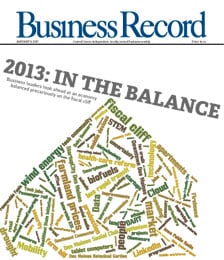Net worth: The Iowa Heart Center puts FilterWire on trial

Cardiologists at the Iowa Heart Center were the first in the state to use a device called FilterWire to treat a heart ailment. The FilterWire EX Embolic Protection System, manufactured by Boston Scientific Corp., was approved by the U.S. Food and Drug Administration on June 9. Nine days later, Dr. L.A. Ionnone used the device on a patient at the Iowa Heart Center office adjacent to Mercy Medical Center in Des Moines.
The speed of adopting such a newly approved was impressive, but in fact Iowa Heart’s involvement with the tool, which acts as a sort of micro-filter to prevent arteries from becoming blocked, goes back much further. In 2001, Iowa Heart was one of only 55 medical centers chosen to take part in a clinical study of the FilterWire, nicknamed FIRE.
Dr. Mark Tannenbaum, a New Yorker-turned-Iowan, led the Iowa Heart Center’s trial of the device. The Mount Sinai School of Medicine-trained physician came to Iowa because he wanted to practice interventional cardiology, and the Midwest was known for having large cardiology centers and a wealth of patients in need of cardiac care. He has been with the Iowa Heart Center, one of the largest private cardiology practices in the nation, since 1989.
In coronary artery bypass surgery, a blocked artery is treated by taking a blood vessel, often a saphenous vein from the patient’s leg, and using it to give blood a new pathway to the heart, bypassing an artery that has become narrowed or blocked.
Approximately 50 percent of patients with bypass surgery using saphenous veins experience some blockage in the vessel within five years. Within 10 to 15 years of the surgery, half of patients experience total blockage, and 85 to 90 percent experience some blockage, Tannenbaum said.
“Bypass surgery was risky,” he said. “People didn’t want to do it.”
When such blockage, known as saphenous vein graft disease, is detected, the prescribed treatment is often angioplasty. In an angioplasty, a catheter is inserted through an artery in the groin or arm and threaded through to the blockage. A balloon attached to the catheter is then inflated to break up the cholesterol or other debris. A stent, which is a small, expandable tube, is sometimes inserted to improve blood flow and prevent the artery wall from collapsing or closing off again.
One danger of an angioplasty is that pieces of debris – mostly cholesterol and blood clots – can travel further down the blood vessels, lodging in the narrower ends and causing further complications. Debris from the old veins is especially dangerous because of its consistency, which some doctors compare to cottage cheese.
In February 1999, the Iowa Heart Center took part in the trial of a device called Percusurge, which fights the problem by placing a balloon downstream of the blockage to catch any debris dislodged during an angioplasty.
Doctors found that the device did reduce the occurrence of heart attacks, but the Percusurge is very fragile. Because it blocks blood flow, the technique involves a sort of race against the clock. If blood flow is blocked for too long, a heart attack occurs.
The FilterWire device was designed to solve those problems. Tannenbaum describes it as a tiny butterfly net. It consists of a flexible, collapsible metal loop that expands a filter of laser-cut holes downstream of the site of the angioplasty. The holes are large enough to let red blood cells carrying oxygen and nutrients through, but small enough to stop debris.
“It’s an improvement because, one, it allows blood flow and, two, it’s simpler,” Tannenbaum said. “The FilterWire EX system is a major advance in our ability to safely treat these patients.”
According to the results of the FIRE trial, the FilterWire system is “equivalent or slightly better” than the Percusurge system, with a 50 to 60 percent reduction of heart attacks.
TRIAL RUN
Dr. Mark Tannenbaum says participation in experimental trials of new devices or medicines is a valuable way to gain continuing education. When selecting which trials to participate in, he says the Iowa Heart Center has some trusted work partners and some general criteria.
“Our goal is to pick trials where we think there’s a novel technique or technology that will benefit our patients and that we can bring them sooner without the delays of the (Food and Drug Administration) regulatory process,” Tannenbaum said. “Fundamentally, we’re looking for something that will impact the care of patients.”
The Iowa Heart Center is currently participating in a trial that studies the effect of cooling heart attack patients to 33 degrees Celsius to slow metabolic processes. According to studies of cooling animals and preliminary results in humans, the practice appears to reduce the severity of heart attacks.






